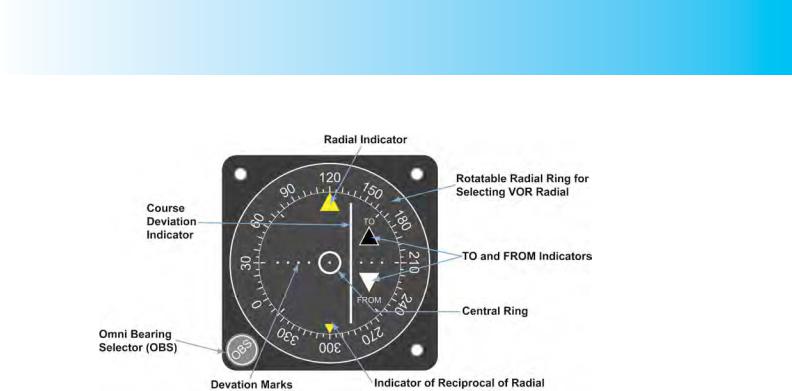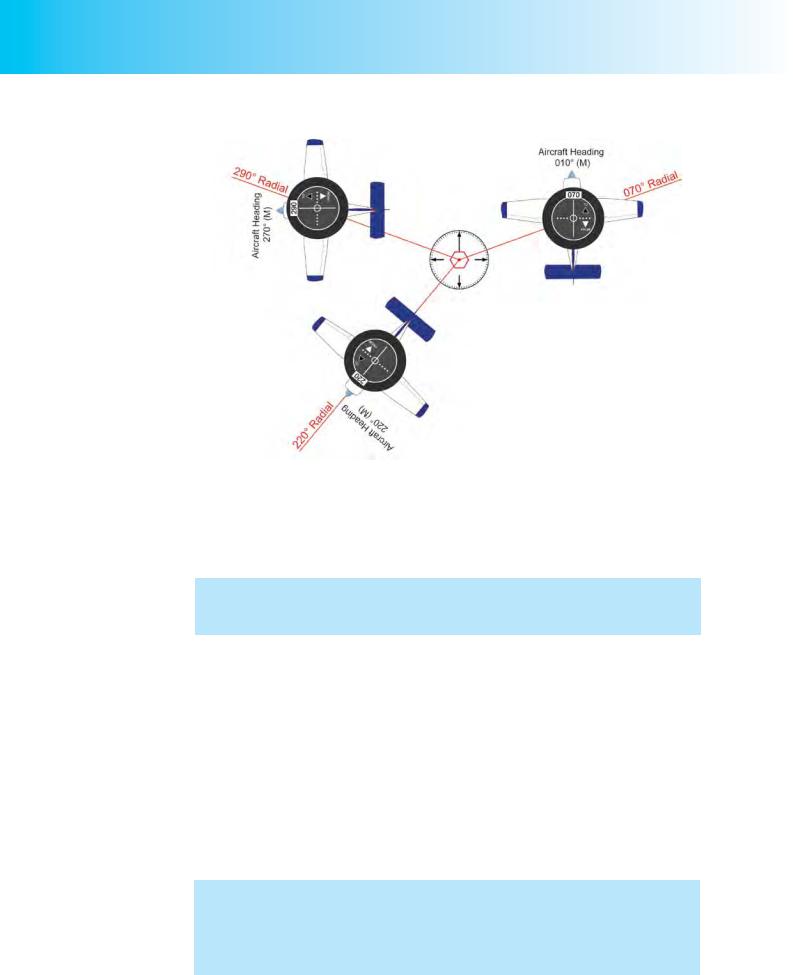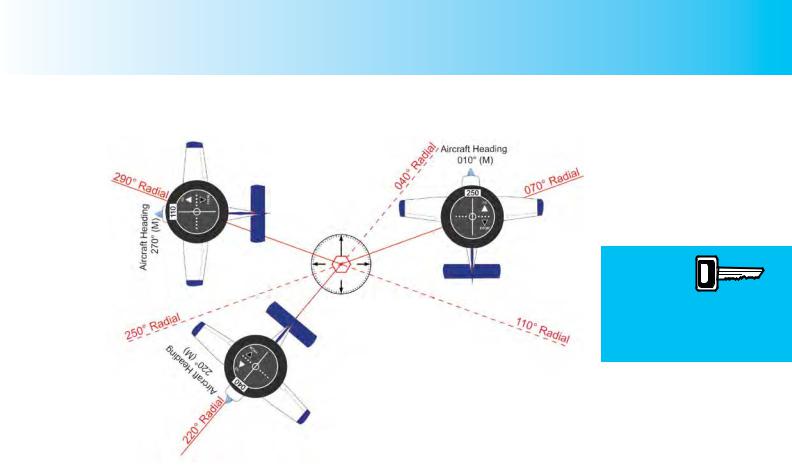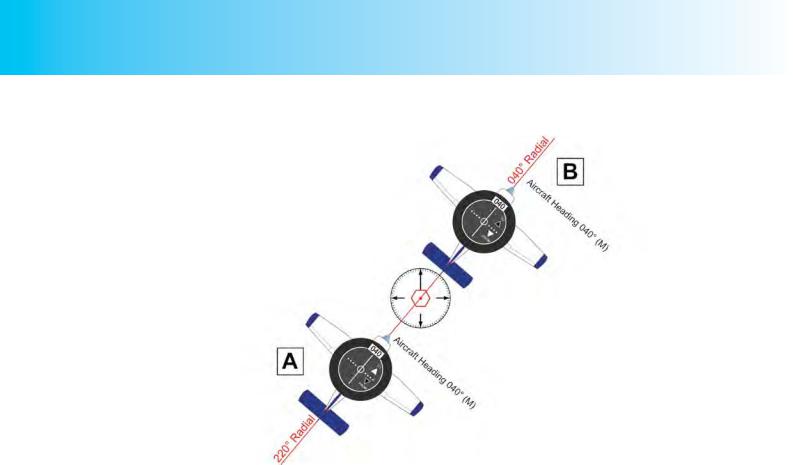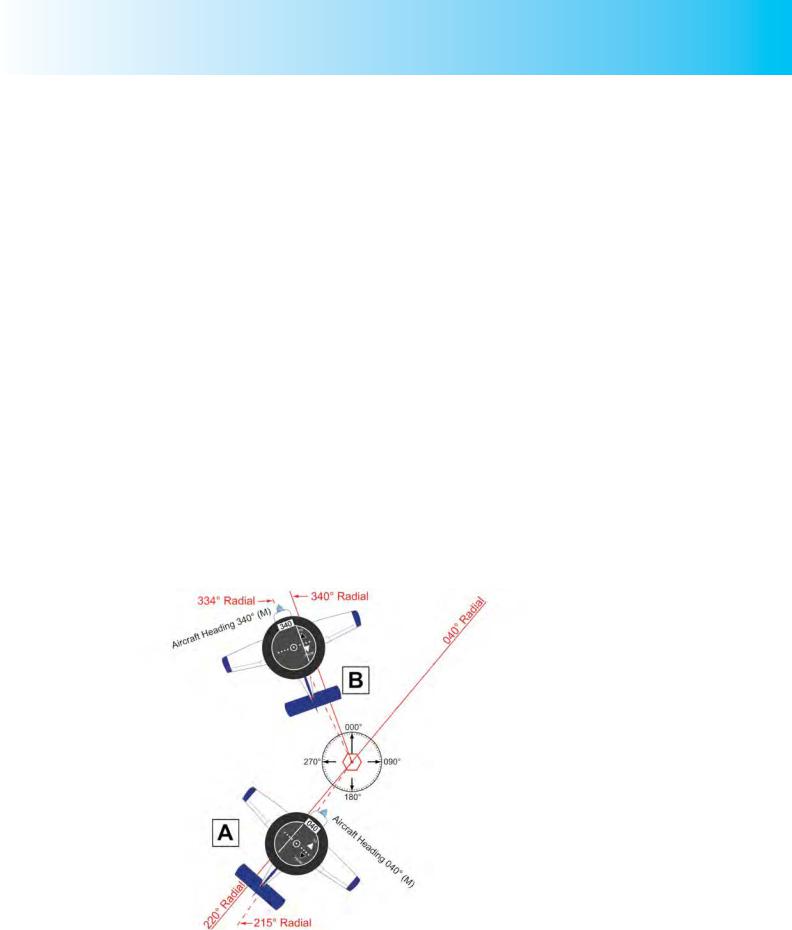
ppl_03_e2
.pdf
ID: 3658
Customer: Oleg Ostapenko E-mail: ostapenko2002@yahoo.com
Customer: Oleg Ostapenko E-mail: ostapenko2002@yahoo.com
CHAPTER 17: VHF OMNI-DIRECTIONAL RANGE (VOR)
Figure 17.4 shows the VOR beacon (co-located with a Distance Measuring Equipment (DME) Facility) located at Strumble near Fishguard, indicated by a compass rose aligned with respect to Magnetic North. A photograph of the actual beacon is also shown.
Notice how the four arrows of the VOR compass rose point away from the beacon symbol. This fact should help you remember that VOR radials are always identified by their bearing away (radiating) from the VOR beacon.
Range and Accuracy.
The range of a VOR transmission depends on the power of the beacon and on the VHF line-of sight limitation. For a transmitter of a given power rating, the higher an aircraft’s altitude, the greater will be the range at which it can receive and use VOR transmissions. When aircraft, such as airliners, operate at very high altitude they are liable to suffer interference from VORs which, though widely separated from one another, are transmitting on the same frequency.
Information on the lateral and vertical range (Designated Operational Coverage (DOC)) of VORs is contained in the En-Route (ENR) section of the United Kingdom Aeronautical Information publication (UK AIP) (ENR 4-1-1). For instance, the AIP tells us that the Strumble VOR/DME has a DOC which varies from 85 nautical miles (nm) to 300 nm, depending on the bearing sector of the transmission, and that it can be used up to an altitude varying from 50 000 feet to 70 000 feet (again depending on the bearing sector), without the likelihood of interference from other VOR beacons. Coastal VOR beacons tend to be more powerful and have a longer range than inland VOR beacons. Cranfield VOR, an inland beacon, has a published DOC of
50 nm/25 000 feet.
VOR systems are very accurate, capable of achieving an accuracy of under 2° of error. However, airborne equipment error can be up to about +/- 3°. The aggregate of all errors to which the VOR is susceptible is around +/- 5°.
Uses of VOR.
The VOR has become one of the world’s primary short range radio-navigational aids because of its accuracy, reliability and ease of pilot-interpretation. Though the range of VOR is restricted by the VHF line-of-sight limitation, the system suffers from few of the disadvantages to which the NDB/ADF system is prone. VOR is not so liable to be affected by the proximity of electrical storms, and, because its signals are line-of-sight, the VOR does not suffer from night effect caused by the reflection of lower frequency signals from the ionosphere. Neither are VOR signals susceptible to bending around terrain features or when crossing coastlines.
Using the VOR system, a pilot may navigate from one VOR beacon to another, or, if he has two VOR receivers and displays in his aircraft, track towards or away from one VOR beacon, along any chosen radial, and then intercept a designated radial from a second VOR beacon, and turn to track towards that beacon.
A pilot may determine his position by selecting two different VOR beacons, noting his magnetic bearing from each beacon, and drawing the lines on his chart. The compass rose, aligned on Magnetic North, which surrounds the VOR beacon locations on the
1:500 000 Chart, helps the pilot to fix his position in the air.
Ground fixes may also be determined approximately by drawing a VOR radial which cuts a large angle across a significant and unique line feature on the ground, such as a particular stretch of coastline. And, as you will learn in a later chapter, position may be determined by reading off a DME range along a selected VOR radial.
VOR radials
are always identified by
their bearing
away from the VOR beacon
307
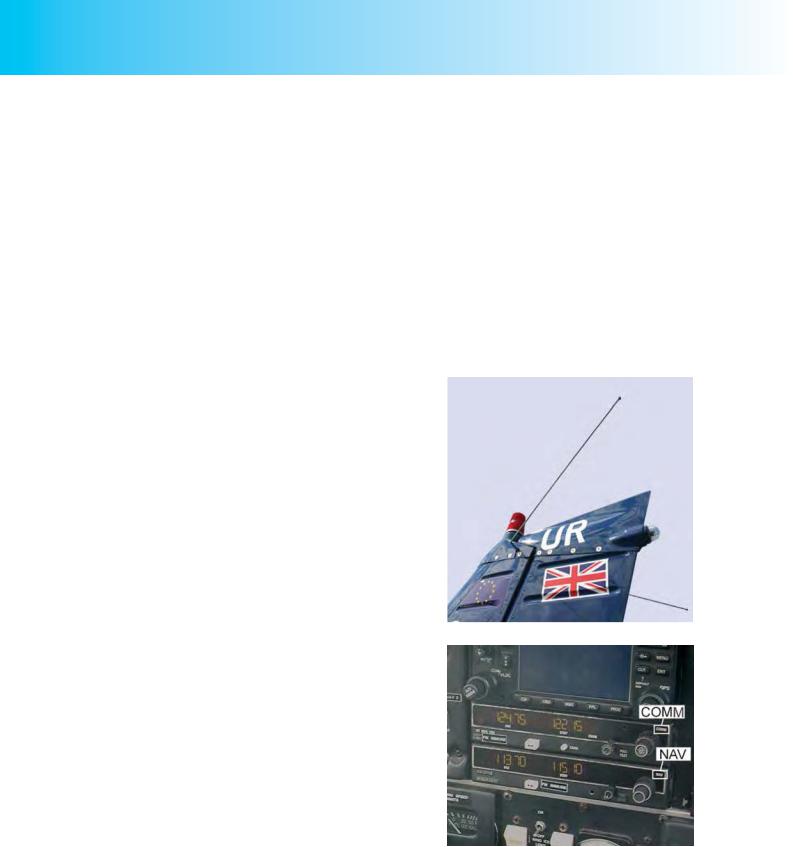
Order: 6026
Customer: Oleg Ostapenko E-mail: ostapenko2002@yahoo.com
Customer: Oleg Ostapenko E-mail: ostapenko2002@yahoo.com
CHAPTER 17: VHF OMNI-DIRECTIONAL RANGE (VOR)
Most airways systems were developed with VORs determining the routes, giving aircrew much better instrument presentation than the older NDBs and Marker beacons. Navigational reference points, or waypoints, can also be defined by the point at which two radials from different VOR beacons intersect each other, or by a VOR radial and a DME distance intersection.
Other uses of VOR are:
•As a let-down and approach aid at aerodromes, using published procedures.
•As a holding beacon.
VOR AIRBORNE EQUIPMENT.
Aerials.
On low-speed, light aircraft, the VOR aerial is normally a whip-type aerial fitted on the fin or beneath the forward part of the fuselage. (See Figure 17.5.)
On high-speed aircraft, VOR antennae are usually blade-type aerials, or else are mounted flush with the airframe;
again, often on the fin.
The VOR Receiver.
The frequency operating range of the VOR beacon is from 108.00 MHz to 117.95 MHz, a range which is just below the VHF voice communication range of 118 MHz to just under 137 MHz.
The airborne element of VOR requires a dedicated receiver, often labelled NAV, and which in many aircraft is located alongside the COMM receiver. (See Figure 17.6.)
VOR Instrument Displays.
Omni Bearing Indicators.
You may see several types of VOR instrument display, but the most widely used in light aircraft are the types illustrated at Figures 17.7 which are sometimes called Omni Bearing Indicators (OBI) for reasons which should become clear as you work your way through this chapter.
Figure 17.5 A whip-type VOR aerial.
Figure 17.6 The VOR receiver (NAV) alongside the VHF voice communication receiver (COMM).
308
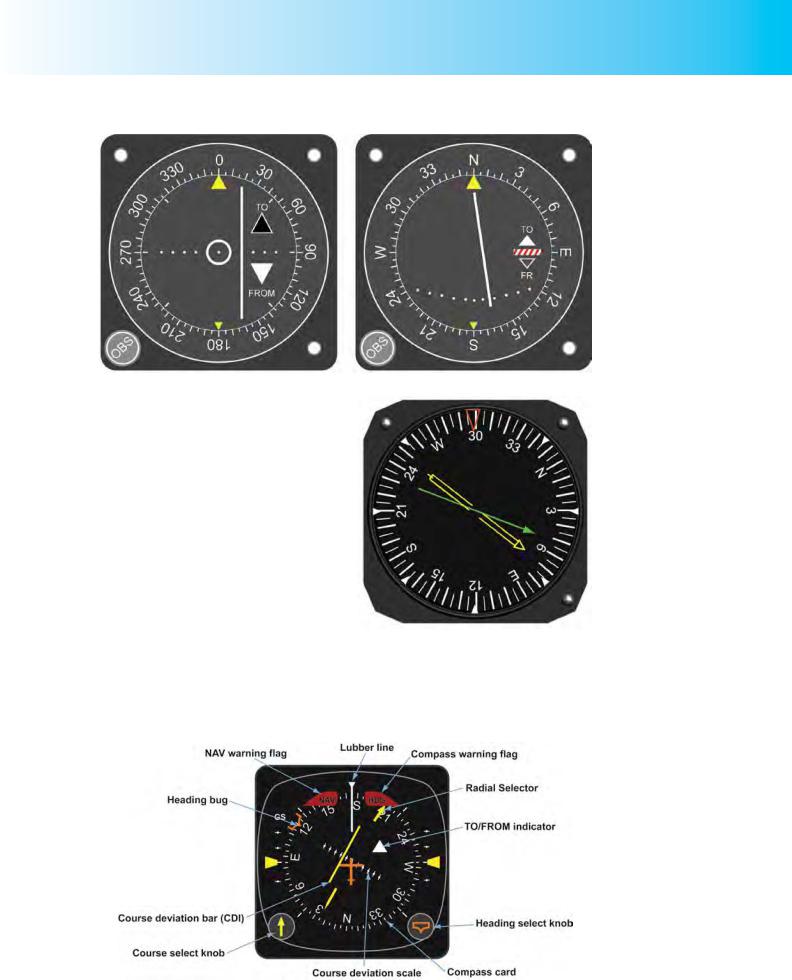
ID: 3658
Customer: Oleg Ostapenko E-mail: ostapenko2002@yahoo.com
Customer: Oleg Ostapenko E-mail: ostapenko2002@yahoo.com
CHAPTER 17: VHF OMNI-DIRECTIONAL RANGE (VOR)
Figure 17.7 Two types of Omni Bearing Indicator.
Radio Magnetic Indicators.
A VOR indicator may also be incorporated in a Radio Magnetic Indicator (RMI) (see Chapter 16), as depicted in Figure 17.8. RMIs of this type usually have two pointers often of a different colour, one which receives inputs from an ADF receiver, normally the broader of the two needles, and one, the narrower of the two, which receives inputs from the VOR receiver. The head of each needle indicates the QDM to the respective beacon. When an aircraft has two VOR receivers with one RMI, the needle will be switchable between the VORs.
Figure 17.8 An RMI with VOR and NDB indiacations.
Horizontal Situation Indicators.
The Horizontal Situation Indicator (HSI) (see Figure 17.9) combines a direction indicator, slaved to a master magnetic compass, with a VOR indicator. The HSI shows the aircraft’s magnetic heading and its orientation with respect to a selected
Figure 17.9 A Horizontal Situation Indicator.
309
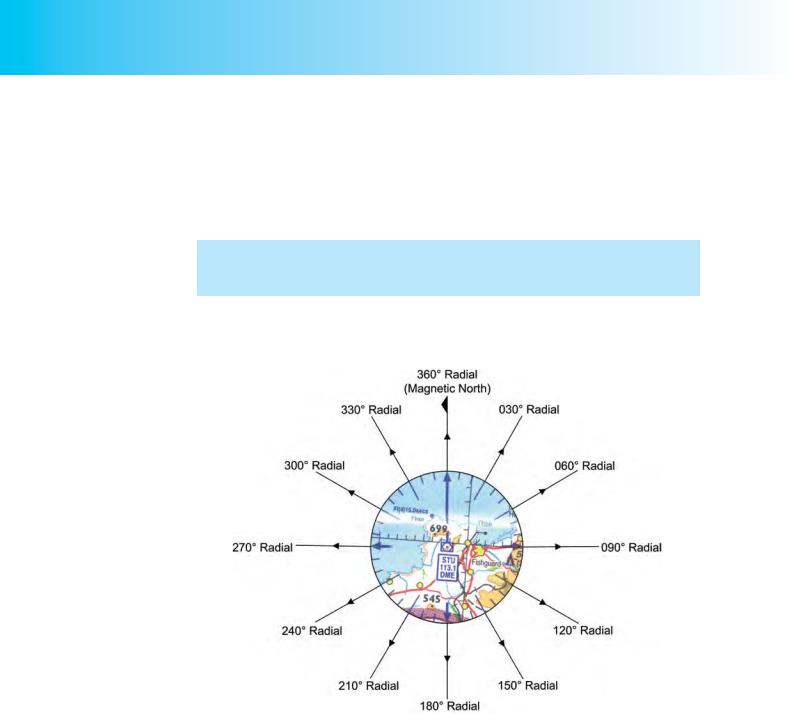
Order: 6026
Customer: Oleg Ostapenko E-mail: ostapenko2002@yahoo.com
Customer: Oleg Ostapenko E-mail: ostapenko2002@yahoo.com
CHAPTER 17: VHF OMNI-DIRECTIONAL RANGE (VOR)
VOR radial, whether the aircraft is on the radial, paralleling the selected radial, on an interception heading to the radial, or diverging from it. HSIs are very easy to interpret and are fitted to almost all commercial aircraft. But, being expensive to acquire, they are not often found in light aircraft operated by flying clubs. For this reason, we will use the Omni Bearing Indicator (OBI) to illustrate the teaching points made in this chapter.
For the purposes of this chapter, we will use the OBI type of VOR indicator, as it is the most common VOR instrument display in basic single engine general aviation aircraft.
OBI Indications.
As you have already learnt, a VOR beacon transmits radials relative to Magnetic
North at the VOR beacon’s location. (See Figure 17.10.)
Figure 17.10 A VOR beacon transmits continuous radials through 360º.
A VOR display of the OBI type is able to indicate any radial selected by the pilot, using the Omni Bearing Selector (OBS) knob on the front of the instrument. Consequently, any radial emanating from the VOR beacon can be used by the pilot as position lines to help him fix the position of his aircraft, or as tracks that he can follow, either to or from the VOR beacon.
Let us examine, first of all, the component parts of the OBI VOR display, how the instrument functions, and the nature of its indications. The different elements of the OBI instrument and its display are illustrated at Figure 17.11, opposite.
The radial ring, calibrated from 0° to 360° at 5° intervals, is rotated by the pilot to select any VOR radial, either in order to obtain a position line or to select a track along which he wishes to fly TO or FROM the VOR beacon. In Figure 17.11, opposite, the
